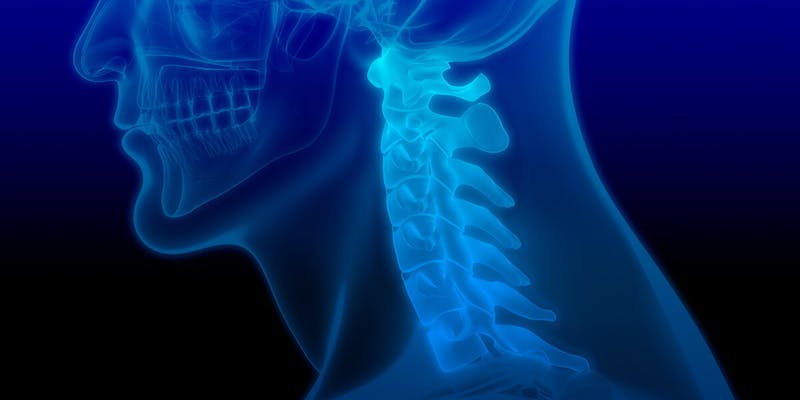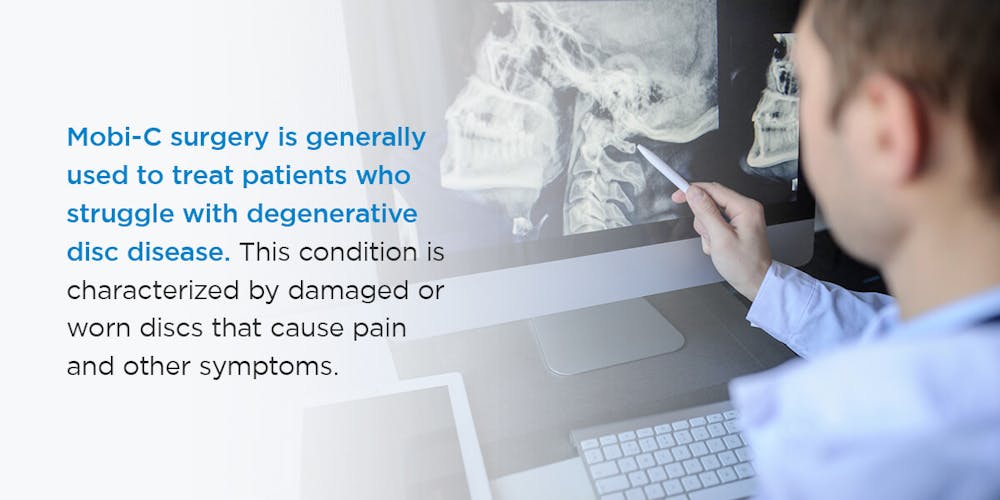
The Mobi-C or Mobi-C® Cervical Disc procedure involves replacing the cervical disc with an artificial version. The Mobi-C is created using high-quality materials, such as cobalt chromium alloy endplates and titanium. The quality of the Mobi-C makes it one of the most commonly used artificial cervical discs.
Healthy discs aid the body in bending and rotating. Mobi-C artificial disc surgery aims to replace a worn-out disc in the spine to improve patient mobility. Artificial disc surgery is often a better alternative to spinal fusion surgeries, which stops motion at the disc and further limits movement. Mobi-C artificial disc surgery also puts less stress on surrounding discs.
Conditions Treated with the Cervical Mobi-C Surgery

Mobi-C surgery is generally used to treat patients who struggle with degenerative disc disease. This condition is characterized by damaged or worn discs that cause pain and other symptoms. Degenerative disc disease can create limited flexibility, weakness and pain from pinched nerves and thinning discs.
Different spinal conditions can contribute to degenerative disc disease, worsening symptoms and impacting quality of life. Mobi-C surgery can help you find relief, but only some patients are good candidates for the surgery. You could be a good candidate if you:
- Are an adult: Your vertebrae need to be mature for the Mobi-C surgery, so adults between 21 and 67 are the best candidates. The disc damage must also occur adjacent or contiguous from each other between vertebrae levels C3 to C7.
- Have pain or neurological symptoms: Patients with pain, numbness, weakness or tingling due to disc damage are good candidates for Mobi-C surgery.
- Have proven disc damage: Your doctor needs to prove disc damage before recommending the Mobi-C surgery, which can be done through X-rays, MRIs and CT scans. Disc damage can show up on imaging as inner discs squeezing through outer discs, loss of disc height or degeneration of the spinal column due to wear and tear.
- Haven’t responded to non-surgical treatment: If you experience pain from disc damage and haven’t responded to nonsurgical treatment, cervical Mobi-C surgery could be an effective alternative. If you’ve tried at least six weeks of alternatives, such as physical therapy or medication, or your condition worsens, talk to your doctor about Mobi-C surgery.
How Long Does Mobi-C Surgery Take?
Mobi-C surgery can take anywhere between one to three hours, depending on the severity of the condition. Mobi-C surgery generally involves the same steps, including:
1. Prepare the Patient
The first step of Mobi-C surgery is to prepare the patient. Upon entering the operating room, your surgical team will position you on the operating table and administer anesthesia. Once you’re unconscious, they will clean the surgical site and prep it with an antiseptic solution.
2. Make an Incision
After you’ve been prepared for surgery, your surgeon will make a 2-inch incision and retract any arteries, the trachea, esophagus and muscles at the front of the spine to allow for access to the damaged discs.
3. Find the Disc Damage
Once the incision has provided access to the different discs, a scope is used to guide needles into the disc to confirm the damage. Pins are inserted into the vertebrae below and above the damaged discs to spread the bones apart for easier access.
4. Remove the Damaged Disc
Your surgeon will use small grasping tools to remove the damaged disc, leaving room for the Mobi-C replacement.
5. Decompress Any Surrounding Nerves
Your surgeon will look for any signs of compressed nerves during the surgery, such as bone spurs. Decompressing surrounding nerves will help improve symptoms and reduce pain.
6. Prepare the Mobi-C Implant
The new space leftover from the removed disc is measured, and a trial implant size is selected. The trial implant is tested in the new leftover area, and imaging is complete to ensure a proper fit. You may need a few trials during the surgery until your surgeon finds the right fit. Once your surgeon determines the proper size, they place a permanent implant in the open space.
7. Close the Incision
Once the Mobi-C implant is in place, the surgeon removes the pins and sutures the muscles and skin closed. Skin glue is often placed across the incision to help it stay closed during recovery.
Mobi-C Cervical Disc Replacement Recovery Process
Once your surgery is complete, you’ll be moved from the operating room to the recovery room. Nurses will monitor your vitals and address any pain you experience after surgery. Most people can return home the same day, but your medical team will ensure you can first make minor movements, such as sitting or walking short distances. If you have challenges with little movements, difficulty breathing or poor vitals, you may need to stay in the hospital overnight for close monitoring.
Since the surgery goes through the neck, some patients experience a sore throat or hoarseness, but these symptoms resolve within one to four weeks.
Your medical team will provide aftercare instructions, which include incision care and physical restrictions. Incision care will consist of properly cleaning the incision and what not to do to the incision site, such as submerging in water or applying lotion. Restrictions can include:
- Avoiding lifting anything heavier than 5 pounds.
- Avoid alcoholic beverages, especially when taking pain medications.
- Eliminating strenuous activity, such as yardwork, housework or other physical labor.
- Avoid driving in the days after surgery or when taking muscle relaxers or pain medications.
- Avoiding bending or twisting movements.
Your doctor will tell you how long you need to follow restriction and incision guidelines, which can last as long as six weeks.
Potential Mobi-C Disc Complications
Every surgery has the risk of complications, including Mobi-C disc surgery. All surgeries will have the same potential complications, including:
- Infections at the incision site.
- Challenges with wound healing.
- Reactions to medications or anesthesia.
- Problems breathing or with your gastrointestinal system.
These complications are less common compared to successful surgery. However, it’s essential to be aware of the potential complications so you can look out for them and seek medical attention when necessary. Mobi-C disc surgery also has specific complications, such as:
- Limited neck movement from fused vertebrae, stiff ligaments and bone overgrowth.
- Mobi-C implants wearing, breaking or moving.
- Recurring spinal problems and/or new spinal problems.
- The need for additional neck surgery.
Despite the risk of complications, Mobi-C surgery helps reduce pain and the need for secondary spinal surgeries, helping improve the overall quality of life. The Mobi-C failure rate is also less than a successful surgery, and your doctor will discuss the risks and benefits with you before you commit to the surgery.
Contact the Spine Specialists at New York Spine Institute
The New York Spine Institute is a reliable multispecialty spine center in the New York area. Our team of experienced surgeons can help you find relief from your pain, whether you deal with degenerative disc disease or another spinal condition. We’re experts at treating anything from simple to complex spinal disorders in adults and children.
If you’ve tried other forms of treatment and haven’t found relief, The New York Spine Institute and our spinal specialists can help. Contact one of our team members to learn more about our treatments, or schedule an appointment for a consultation with one of our specialists.
Linked Sources:
- https://www.nyspine.com/services/orthopedic-division/spine-surgery-mobi-c-cervical-disc-replacement/
- https://www.odtmag.com/contents/view_breaking-news/2018-03-29/study-zimmer-biomets-mobi-c-cervical-disc-associated-with-less-pain-lower-second-surgery-rates/
- https://www.nyspine.com/administration/
- https://www.nyspine.com/schedule-an-appointment/

